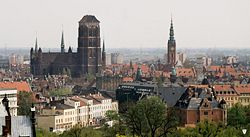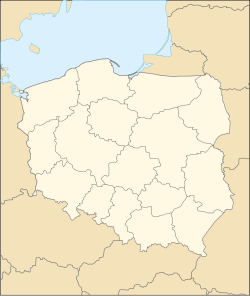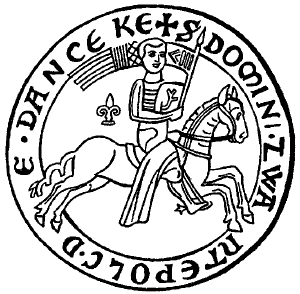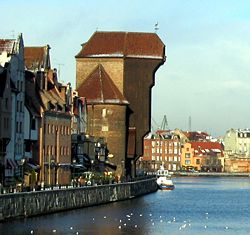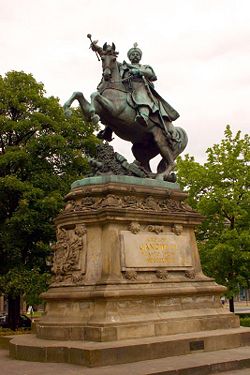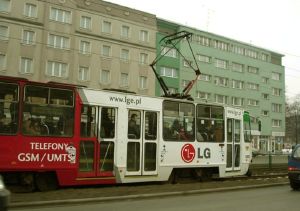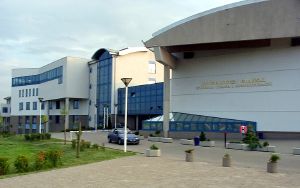Gdansk
| Gdańsk | |||
| Old town | |||
|
|||
| Motto: Nec temere, nec timide (Neither rashness nor timidity) |
|||
| Coordinates: 54°22′N 18°38′E | |||
|---|---|---|---|
| Country | |||
| Voivodeship | Pomeranian | ||
| County | city county | ||
| Established | 10th century | ||
| City rights | 1263 | ||
| Government | |||
| - Mayor | Paweł Adamowicz (PO) | ||
| Area | |||
| - City | 262 km² (101.2 sq mi) | ||
| Population (2006) | |||
| - City | 457,630 | ||
| - Density | 1,746.7/km² (4,523.9/sq mi) | ||
| - Metro | 1,080,700 | ||
| Time zone | CET (UTC+1) | ||
| - Summer (DST) | CEST (UTC+2) | ||
| Postal code | 80-008 to 80-958 | ||
| Area code(s) | +48 58 | ||
| Car plates | GD | ||
| Website: http://www.gdansk.pl | |||
Gdańsk (Polish pronunciation [gdaɲsk] (![]() listen); German: Danzig [ˈdantsɪç] Template:Audlisten, Kashubian: Gduńsk, Latin: Gedania, Dantiscum) is the city at the centre of the fourth-largest metropolitan area in Poland.[1] It is Poland's principal seaport as well as the capital of the Pomeranian Voivodeship. It is also historically the largest city of the Kashubian region.
listen); German: Danzig [ˈdantsɪç] Template:Audlisten, Kashubian: Gduńsk, Latin: Gedania, Dantiscum) is the city at the centre of the fourth-largest metropolitan area in Poland.[1] It is Poland's principal seaport as well as the capital of the Pomeranian Voivodeship. It is also historically the largest city of the Kashubian region.
The city lies on the southern edge of Gdańsk Bay (of the Baltic Sea), in a conurbation with the spa town of Sopot, the city of Gdynia and suburban communities, which together form a metropolitan area called the Tricity (Trójmiasto), with a population of over 800,000.[1] Gdańsk itself has a population of 458,053 (2006), making it the largest city in the Pomerania region of Northern Poland.
Gdańsk is situated at the mouth of the Motława River, connected to the Leniwka, a branch in the delta of the nearby Vistula River, whose waterway system waters 60% of the area of Poland and connects Gdańsk to the national capital in Warsaw. This gives the city a unique advantage as the center of Poland's sea trade. Together with the nearby port of Gdynia, Gdańsk is also an important industrial center. Historically an important seaport and shipbuilding center, Gdańsk was a member of the Hanseatic League.
The city was the birthplace of the Solidarity movement which, under the leadership of Gdańsk political activist Lech Wałęsa, played a major role in bringing an end to communist rule across Central Europe. It is also the home and birthplace of Polish Prime Minister Donald Tusk, who is of Kashubian origin.
Names
See also: List of European cities with names in different languages
The city's name is thought to originate from the Gdania river,[2] the original name of the Motława branch on which the city is situated. Gdańsk and Gdania are considered to be derivations from the Gothic name of the area (Gutiskandja),[3] however this has also been questioned.[4] Like many other Central European cities, Gdańsk has had many different names throughout its history.
The name Gdańsk is usually pronounced /gəˈdɑːnsk/, /gəˈdaɪnsk/, or /gəˈdænsk/ in English. The diacritic over the "n" is frequently omitted by non-Poles. In the local Kashubian language it is known as Gduńsk.
The Germanised version of this name, Danzig, has been used by the German population, as well as in English[5] until the end of World War II. Other former English versions of its name include Dantzig, Dantsic, and Dantzic. The city's Latin name may be given as either Gedania, Gedanum or Dantiscum; the variety of Latin names reflects the mixed influence of the city's Polish, German and Kashubian heritage.
The name of a settlement was recorded after St. Adalbert's demise in 997 C.E. as urbs Gyddanyzc and later was written as Kdanzk (1148), Gdanzc (1188), Danceke[6] (1228), Gdansk (1236), Danzc (1263), Danczk (1311, 1399, 1410, 1414-1438), Danczik (1399, 1410, 1414), Danczig (1414), Gdansk (1454, 1468, 1484), Gdansk (1590), Gdąnsk (1636) and in Latin documents Gedanum or Dantiscum.
Ceremonial names
On special occasions it is also known as The Royal Polish City of Gdańsk (Polish: Królewskie Polskie Miasto Gdańsk, Latin: Regia Civitas Polonica Gedanensis, Kashubian: Królewsczi Polsczi Gard Gduńsk).[7][8][9]
The Kashubians prefer the name: Our Capital City Gdańsk (Nasz Stoleczny Gard Gduńsk) or The Kashubian Capital City Gdańsk (Stoleczny Kaszëbsczi Gard Gduńsk).
History
Foundation and the Middle Ages
According to archaeologists, a stronghold was built at Gdańsk in the 980s by Mieszko I of Poland, after a series of wars against the local tribes. Modern day Poles have come to regard this as the founding of Gdańsk; in 1997 the city celebrated the millennial anniversary of the year 997 when Saint Adalbert of Prague baptized the inhabitants of the settlement on behalf of Boleslaw the Brave of Poland. In 1186, a Cistercian monastery was set up in Oliva nearby (now within the city limits).
Gdańsk in 1215 became the main burgh of a Pomerelian splinter duchy. In 1224/25, Germans in the course of the Ostsiedlung established Danzig in the area of the earlier fortress. In 1226, the town was granted an Lübeck law by Swantopolk II, an autonomy charter similar to that of Lübeck. Danzig gained great importance in the Baltic area as a city of merchants and trade and as a port city. While at this time the surrounding lands were inhabited by Pomeranians, Danzig soon became a starting point for the German settlement of the largely fallow Vistula land.
By 1308, after a decade of struggles for Pomerelia inheritance between the Margraviate of Brandenburg and Poland, Danzig was taken over by the Order of the Teutonic Knights. The knights were called in by the Poles to aid a Polish garrison holding out in the fortress while the city was controlled by Brandenburg. Yet, after disputes arose with the Poles, the knights kept the city for themselves and integrated Danzig in their Teutonic Monastic State of Prussia. After a series of Polish-Teutonic Wars, in the Treaty of Kalisz (1343) the Order had to acknowledge that it would hold Pomerelia as an alm from the Polish Crown. Although it left the legal basis of the Order's possession of the province in some doubt, the city thrived as a result of increased exports of grain (especially wheat), timber, potas, tar, and other goods of forestry from Poland via the Vistula River trading routes. While under the control of the Teutonic Order, the city and its trade prospered, German migration increased, and the city became a full member of the Hanseatic League in 1361.
A new war broke out in 1409, ending with the Battle of Grunwald (1410), and the city came willingly under the control of the Kingdom of Poland . A year later, with the first First Peace of Thorn, it returned to the Teutonic Order. In 1440, the city participated in the foundation of the Prussian Confederation which led to the Thirteen Years' War of independence from the Teutonic Monastic State of Prussia (1454-1466).
This intermittent warfare ended on May 25, 1457, when the city - jointly with Royal Prussia - came under the protective sovereignty of the Crown of Poland while maintaining its rights and independence as an autonomous city.[10][11] Gaining free and privileged access for the first time to Polish markets, the seaport prospered while simultaneously trading with the other Hanseatic cities. After the Second Peace of Thorn (1466) with the Teutonic Monastic State of Prussia the warfare between the latter and the Polish crown ended permanently. After the incorporation of Royal Prussia by the Kingdom of Poland in 1569, the city continued to enjoy a large degree of internal autonomy (cf. Danzig Law).
King Stephen Báthory's attempt to subject the city, which had supported Maximilian II in the prior election of the king, failed. The city, encouraged by its immense wealth and almost impregnable fortifications, as well as by the secret support of Denmark and Emperor Maximilian, shut its gates against Stephen. After the Siege of Danzig (1577), lasting six months, the city's army of 5,000 mercenaries was utterly defeated in a field battle on December 16, 1577. However, since Stephen's armies were unable to take the city by force, a compromise was reached: Stephen Báthory confirmed the city's special status and her Danzig Law privileges granted by earlier Polish kings. The city recognised him as ruler of Poland and paid the enormous sum of 200,000 guldens in gold as payoff ("apology").
Beside the German-speaking majority, whose elites sometimes distinguished their German dialect as Pomerelian,[12] the city was home to a large number of Polish-speaking Poles, Jewish Poles, and Dutch. In addition, a number of Scotsmen took refuge or immigrated to and received citizenship in the city. During the Protestant Reformation, most German-speaking inhabitants adopted Lutheranism.
The city suffered a slow economic decline due to the wars of the 18th century, when it was taken by the Russians after the Siege of Danzig in 1734. Danzig was annexed by the Kingdom of Prussia in 1793, only to be broken off by Napoleon as a pseudo-independent free city from 1807-1814. Returned to Prussia after France's defeat in the Napoleonic Wars, the city became the capital of Regierungsbezirk Danzig within the province of West Prussia from 1815. The city's longest serving Regierungspräsident was Robert von Blumenthal, who held office from 1841, through the revolutions of 1848, until 1863. The city became part of the German Empire in 1871.
The inter-war years, and World War II
When Poland regained its independence after World War I with access to the sea as promised by the Allies on the basis of Woodrow Wilson's "Fourteen Points", the Poles hoped the city's harbour would also become part of Poland. However, since a 1919 census determined that the city's population was 98% German,[13] it was not placed under Polish sovereignty, but, according to the terms of the Versailles Treaty, became the Free City of Danzig, an independent quasi-state under the auspices of the League of Nations with its external affairs largely under Polish control. This led to a large degree of tension between the city and the surrounding Republic of Poland. The Free City had its own constitution, national anthem, parliament (Volkstag), and government (Senat). It issued its own stamps as well as currency.
The majority of the Free City of Danzig's population favored reincorporation into Germany. In the early 1930s the local Nazi Party capitalized on these pro-German sentiments and in 1933 garnered 38% of vote in the parliament. Thereafter, the Nazis under Gauleiter Albert Forster achieved dominance in the city government, which was still nominally overseen by the League of Nations' High Commissioner. The Nazis demanded the return of Danzig to Germany along with an exterritorial (meaning under German jurisdiction) highway through the area of the Polish Corridor for land-based access between the parts of Germany which had become physically separated after World War I.[14] The Polish government in principle agreed to this proposal until the Anglo-Polish military alliance in March 1939 effectively canceled the German–Polish Non-Aggression Pact of 1934 and ended Polish willingness to negotiate successions. German-Polish relations deteriorated rapidly afterwards, even escalating into border skirmishes. The German Nazi Government, knowing that it's military strength was inferior to the combined British, French, Polish, and Soviet forces, invaded Poland on September 1 only after having secured Soviet approval in late August, hoping to negotiate a peace solution with Britain and France after the end of hostilities.[15] This invasion of Poland is regarded as the beginning of World War II.
World War II began in Danzig, with a bombardment of Polish positions at Westerplatte by the German battleship Schleswig-Holstein, and the landing of German infantry on the peninsula. Polish defenders at Westerplatte resisted for seven days before running out of ammunition. Meanwhile, after a fierce daylong fight, defenders of Polish Post office were shot dead and buried on the spot in the Danzig quarter of Zaspa. To celebrate surrender of Westerplatte, NSDAP organized a night parade on Sep 7th along Adolf-Hitlerstrasse that was inadvertently attacked by a Polish hydroplane taking off from Hel Peninsula. The city was officially annexed by Nazi Germany and incorporated into the Reichsgau Danzig-West Prussia.
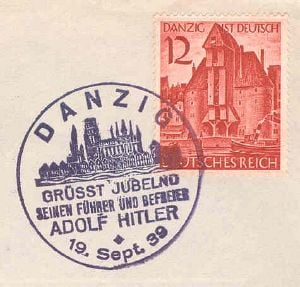
Most of the Jewish community in Danzig were able to escape from the Nazis shortly before the outbreak of war. Nazi secret police had been observing Polish communities since 1936, compiling information which in 1939 served to prepare lists of Poles to be captured in Operation Tannenberg. On the first day of the war, approximately 1,500 ethnic Poles were arrested, some because of their participation in social and economic life, others because they were activists and members of various Polish organizations. On 2 September 1939, 150 of them were deported to the Stutthof concentration camp some 30 miles from Danzig, and murdered.[16] Many Poles living in Danzig were deported to Stutthof or executed in the Piaśnica forest.
In 1941, the Nazi Regime ordered the invasion of the Soviet Union, eventually causing the fortunes of war to turn against it. As the Soviet Army advanced in 1944, German populations in Central and Eastern Europe took flight, resulting in the beginning of a great population shift. After the final Soviet offensive began in January, 1945, hundreds of thousands of German refugees, many of whom had fled to Danzig on foot from East Prussia (see evacuation of East Prussia), tried to escape through the city's port in a large-scale evacuation involving hundreds of German cargo and passenger ships. Some of the ships were sunk by the Soviets, including the Wilhelm Gustloff after an evacuation was attempted at neighboring Gdynia. In the process, tens of thousands of refugees were killed.
The city also endured heavy Allied and Soviet bombardment by air. Those who survived and could not escape encountered the Soviet Army, which captured the city on March 30, 1945 and largely destroyed it.[17] In line with the decisions made by the Allies at the Yalta and Potsdam conferences, the city was returned to Poland after 152 years. The remaining German residents of the city who survived the war fled or were expelled to postwar Germany, and the city was repopulated with ethnic Poles, including many from Polish areas annexed by the Soviet Union who were deported by the Soviets in two major waves from the eastern portion of pre-war Poland.
Contemporary History
The historic old city of Gdańsk, which had suffered large-scale destruction at the hands of the Soviet Army, was rebuilt during the 1950s and 1960s. Boosted by heavy investment in the development of its port and three major shipyards, Gdańsk became the major shipping and industrial center of the Communist People's Republic of Poland.
As part of German-Polish reconciliation policies driven by West German Chancellor Willy Brandt's Ostpolitik, German territorial claims on Gdańsk were renounced, and the city's full incorporation into Poland was recognized in the Treaty of Warsaw in 1970. This was confirmed by a reunited Germany in 1990 and 1991.
In 1970, Gdańsk was the scene of anti-regime demonstrations which led to the downfall of Poland's communist leader Władysław Gomułka. Ten years later the Gdańsk Shipyard was the birthplace of the Solidarity trade union movement, whose opposition to the Communist regime led to the end of Communist Party rule in 1989, and sparked a series of protests that successfully overturned the Communist regimes of the former Soviet bloc. Solidarity's leader, Lech Wałęsa, a native of Gdańsk, became President of Poland in 1990. Gdańsk native Donald Tusk became Prime Minister of Poland in 2007.
Today Gdańsk is a major shipping port and tourist destination and has been the setting for a number of major open air concerts, including Pink Floyd's David Gilmour and Jean Michel Jarre. The Rock band Queen are staging a concert in the Shipyard in October 2008.[18]
Climate
Gdansk enjoys a temperate climate, with cold, cloudy, moderately-severe winters and mild summers with frequent showers and thunderstorms. Average temperatures range from -1.0°C to 17.2°C and rainfall varies from 84.0 mm/month to 210.0 mm/month. In general it is a maritime climate and therefore damp, variable and harsh.
The seasons are clearly differentiated. Spring starts in March and is initially cold and windy, later becoming pleasantly warm and often very sunny. Summer, which begins in June, is predominantly warm but hot at times (with temperature reaching as high as 30-35C at least once per year) with plenty of sunshine interspersed with heavy rain. The average annual hours of sunshine for Gdansk are 1600, similar to other Northern cities. July and August are the hottest months. Autumn comes in September and is at first warm and usually sunny, turning cold, damp and foggy in November. Winter lasts from December to March and includes periods of snow. January and February are the coldest months with the temperature sometimes dropping as low as -15°C.
Economy
The industrial sections of the city are dominated by shipbuilding, petrochemical and chemical industries, and food processing. The share of high-tech sectors such as electronics, telecommunications, IT engineering, cosmetics and pharmaceuticals is on the rise. Amber processing is also an important part of the local economy, as the majority of the world's amber deposits lie along the Baltic coast. The Pomeranian Voivodeship, including Gdańsk, is also a major tourist destination in the summer months, as millions of Poles and European Union citizens flock to the beaches of the Baltic coastline.
Main sights
The city has many fine buildings from the time of the Hanseatic League. Most tourist attractions are located along or near Ulica Długa (Long Street) and Długi Targ (Long Market), a pedestrian thoroughfare surrounded by buildings reconstructed in historical (primarily 17th century) style and flanked at both ends by elaborate city gates. This part of the city is sometimes referred to as the Royal Road as the former path of processions for visiting kings.
Walking from end to end, sites encountered on or near the Royal Way include:
- Upland Gate (Brama Wyżynna)
- Torture House (Katownia)
- Prison Tower (Wieża więzienna)
- Golden Gate (Brama Złota)
- Long Street (Ulica Długa)
- Uphagen House (Dom Uphagena)
- Main Town Hall (Ratusz Głównego Miasta)
- Long Market (Długi Targ)
- Arthur's Court (Dwór Artusa)
- Neptune Fountain (Studnia Neptuna)
- Golden House (Złota kamienica)
- Green Gate (Brama Zielona)
Gdańsk has a number of historical churches:
- St. Bridget
- St. Catherine
- St. John
- St Mary (Bazylika Mariacka), a municipal church built during the 15th century, is the largest brick church in the world.
- St Nicholas' Church
- Church of the Holy Trinity
The museum ship SS Soldek is anchored on the Motława River.
In the 16th century, Gdańsk hosted Shakespearean theatre on foreign tours, and the Danzig Research Society founded in 1743 was one of the first of its kind. Currently, there is a Fundation Theatrum Gedanensis aimed at rebuilding the Shakespeare theatre at its historical site. It is expected that Gdańsk will have a permanent English-language theatre, as at present it is only an annual event.
Transportation
- Gdańsk Lech Wałęsa Airport - an international airport located in Gdańsk;
- Port of Gdańsk - a seaport located on the southern coast of Gdańsk Bay within the city;
- Szybka Kolej Miejska - an urban transportation service of Tricity;
- Obwodnica Trojmiejska - an expressway that bypasses the cities of Gdynia, Sopot and Gdańsk.
Train transportation provides good connection with all major Polish cities, and with the neighbouring Kashubian Lakes region. The A-1 Highway currently under construction will connect the port and city of Gdańsk with the southern border of the country.
Gdańsk is the starting point of the EuroVelo 9 cycling route which continues southward through Poland, then into the Czech Republic, Austria and Slovenia before ending at the Adriatic Sea in Pula, Croatia.
Sports
There are many popular professional sports teams in the Gdańsk and Tricity area. Amateur sports are played by thousands of Gdańsk citizens and also in schools of all levels (elementary, secondary, university). One of the most popular sports in Gdańsk is football. The most famous team is Lechia Gdansk. Founded in 1945, they play in the second league. In the season 2007/2008 Lechia was promoted to the first league(Orange Ekstraklasa)Lechia stadium "MOSIR" is situated on Traugutta Street 29 in Gdańsk, opposite the Medical University of Gdańsk. The city will be one of the four stadias in Poland that will host Euro 2012, in the joint bid, Poland/Ukraine.
Politics and local government
Contemporary Gdańsk is the capital of the province called Pomeranian Voivodeship and is one of the major centres of economic and administrative life in Poland. Many important agencies of the state and local government levels have their main offices here: the Provincial Administration Office, the Provincial Government, the Ministerial Agency of the State Treasury, the Agency for Consumer and Competition Protection, the National Insurance regional office, the Court of Appeal, and the High Administrative Court.
Regional centre
Gdańsk Voivodeship was extended in 1999 to include most of former Słupsk Voivodeship, the western part of Elbląg Voivodeship and Chojnice County from Bydgoszcz Voivodeship to form the new Pomeranian Voivodeship. The area of the region was thus extended from 7,394 km² to 18,293 km² and the population rose from 1,333,800 (1980) to 2,198,000 (2000). By 1998, Tricity constituted an absolute majority of the population; almost half of the inhabitants of the new region live in the centre.
Education and science
There are 14 universities with a total of 60,436 students, including 10,439 graduates as of 2001.
- Gdańsk University (Uniwersytet Gdański)
- Gdańsk University of Technology (Politechnika Gdańska)
- Medical University (Akademia Medyczna)
- Academy of Physical Education and Sport of Gdansk (Akademia Wychowania Fizycznego i Sportu im. Jędrzeja Śniadeckiego)
- Musical Academy (Akademia Muzyczna im. Stanisława Moniuszki)
- Arts Academy (Akademia Sztuk Pięknych) [8]
- Instytut Budownictwa Wodnego PAN
- Ateneum – Szkoła Wyższa
- Gdańska Wyższa Szkoła Humanistyczna
- Gdańska Wyższa Szkoła Administracji
- Wyższa Szkoła Bankowa
- Wyższa Szkoła Społeczno-Ekonomiczna
- Wyższa Szkoła Turystyki i Hotelarstwa w Gdańsku
- Wyższa Szkoła Zarządzania
Scientific and regional organizations
- Gdańsk Scientific Society
- Baltic Institute (Instytut Bałtycki), established 1925 in Toruń, since 1946 (?) in Gdańsk
- TNOiK - Towarzystwo Naukowe Organizacji i Kierowania (Scientific Society for Organization and Management) O/Gdańsk
- IBNGR - Instytut Badań nad Gospodarką Rynkową (The Gdańsk Institute for Market Economics) [9]
Looking to the future
Notes
- ↑ 1.0 1.1 World Gazetteer: Poland - largest cities (per geographical entity)
- ↑ From the history of Gdańsk city name, as explained at Gdansk Guide [1]
- ↑ Adrian Room, Placenames of the World, 2nd Ed. [2] Quote: "The city has a Gothic name, from Gutisk-andja, "end of the Goths," as these people's territory extended to here. The city's former German name, Danzig, misleadingly suggests an association with the Danes."
- ↑ Dennis H. Green, The Visigoths from the Migration Period to the Seventh Century [3] Quote: "...the difficulty with Gdańsk, Gdynia and gudas... in the Polish coastal area centuries before the Goths are known to have occupied this region... casts doubt on the theory of Gothic origin."
- ↑ Britannica 11th edition (published in 1911), [4]
- ↑ Marian Gumowski: Handbuch der polnischen Siegelkunde, 1966 [5]
- ↑ Gdańsk, in: Kazimierz Rymut, Nazwy Miast Polski, Ossolineum, Wrocław 1987
- ↑ Hubert Gurnowicz, Gdańsk, in: Nazwy miast Pomorza Gdańskiego, Ossolineum, Wrocław 1978
- ↑ Baedeker's Northern Germany, Karl Baedeker Publishing, Leipzig 1904
- ↑ From "Poland. Chronology. [6]
- ↑ From Danzig - Gdansk until 1920 [7]
- ↑ Bömelburg, Hans-Jürgen, Zwischen polnischer Ständegesellschaft und preußischem Obrigkeitsstaat: vom Königlichen Preußen zu Westpreußen (1756-1806), München: Oldenbourg, 1995, (Schriften des Bundesinstituts für Ostdeutsche Kultur und Geschichte (Oldenburg); 5), zugl.: Mainz, Johannes Gutenberg-Univ., Diss., 1993, 549 pp.
- ↑ Encyclopaedia Britannica Year Book, 1938,[verification needed]
- ↑ See Documents Concerning the German Polish Relations and the Outbreak of Hostilities between Great Britain and Germany on September 3, 1939. See also the Soviet archived, Documents Relating to the Eve of the Second World War Volume II: 1938-1939 (New York: International Publishers), 1948.
- ↑ See Documents Concerning the German Polish Relations and the Outbreak of Hostilities between Great Britain and Germany on September 3, 1939. Hitler's change of position is well reflected in Goebbel's personal diary. See also the Soviet archived, Documents Relating to the Eve of the Second World War Volume II: 1938-1939 (New York: International Publishers), 1948.
- ↑ Museums Stutthof in Sztutowo. Accessed January 31, 2007.
- ↑ Gdansk, history. Official website. (English)
- ↑ According to FollowQueen.comFollowQueen.com
ReferencesISBN links support NWE through referral fees
External links
- (English) Official website
- Gdansk Photogallery
- (Polish) Virtual Gdańsk (portal)
Credits
New World Encyclopedia writers and editors rewrote and completed the Wikipedia article in accordance with New World Encyclopedia standards. This article abides by terms of the Creative Commons CC-by-sa 3.0 License (CC-by-sa), which may be used and disseminated with proper attribution. Credit is due under the terms of this license that can reference both the New World Encyclopedia contributors and the selfless volunteer contributors of the Wikimedia Foundation. To cite this article click here for a list of acceptable citing formats.The history of earlier contributions by wikipedians is accessible to researchers here:
The history of this article since it was imported to New World Encyclopedia:
Note: Some restrictions may apply to use of individual images which are separately licensed.
